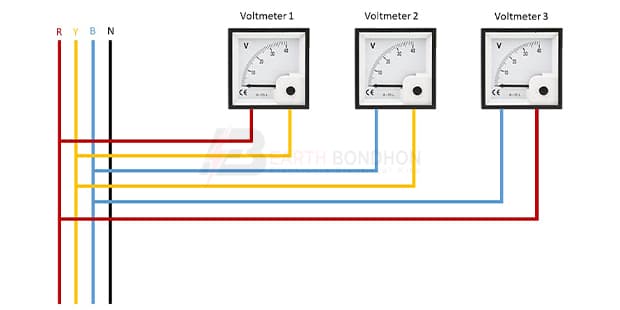Voltmeter connection diagram:
This diagram shows the Voltmeter connection diagram. In this circuit, we use the three-volt meter. This circuit diagram is very simple and easy to make connect it. If you want to know more about this circuit, please check our youtube video below the post. For more information please check our category.
Advertisements
Components needed For this Project:
You can get the components from any of the sites below:
- single phase Volt Meter [See Buy Click Amazon]
*Please note: These are affiliate links. I may make a commission if you buy the components through these links. I would appreciate your support in this way!
Advertisements
Components used to make the Voltmeter connection diagram:
An instrument that measures the potential difference between any two points in a circuit directly in volts is called a voltmeter. A voltmeter is an Electrical instrument that directly measures the potential difference between any 2 points in a circuit in volts. The voltmeter is connected in parallel with the 2 points in the circuit where the potential difference is to be measured. This instrument consists of a galvanometer. Like an electric cell or an ammeter, a voltmeter has 2 terminals, a positive and a negative terminal. Usually, the positive end is red and the negative end is black.
Thank You for visiting the website. Keep visiting for more Updates.
Frequently asked questions
The voltmeter was connected in parallel with the circuit diagram. This means that the voltmeter does not draw any current flow from the circuit diagram and thus does not affect the voltage measurement. The voltmeter is connected to the 2 points in the circuit diagram where you want to measure the voltage drop.
A Voltmeter has very high resistance to ensure that its connection does not alter the flow of current in the circuit. Now if it is connected in series then no current flow will be there in the circuit due to its high resistance. Hence it is connected in parallel to the load across which the potential difference is to be measured.
The formula is volts times the square root of 3, which happens to be rounded off to 1.732. For 2 lines each carrying 120 volts, the calculation for this is 120 volts times 1.732, and the result is rounded up to 208 volts. That's why we call it a 208-volt three-phase circuit, or a 208-volt 3 phase line.
A voltmeter was connected across the points whose p.d is to be measured. If the voltmeter resistance is low, a large current should flow through it, affecting the p.d to be measured. If the voltmeter had high resistance only a very small current flow is taken away from the main circuit by the voltmeter.
A voltmeter is an instrument used for measuring the electrical device potential difference between 2 points in an electric circuit diagram An ammeter is a measuring device used to measure the electric current in a circuit diagram.
Read more Single Phase Wiring
What is a kilowatt-hour (kWh) | kwh formula | What does kwh mean
Introduction to Electrical Units and CircuitskW and kWh on your electricity bill As your home uses electricity during...
What is the Difference Between kVA | What does KVA mean | kVA formula
Difference Between KVA ExplainedWhat does KVA Mean? There are technical terms aplenty when it comes to generators, and...
Power Factor | Power Unit | Energy | Electricity Unit
Power factor definition | Calculating Power FactorPower Factor Values In a purely resistive circuit, the power factor...


0 Comments